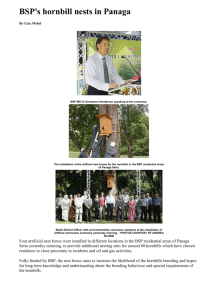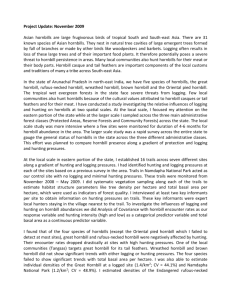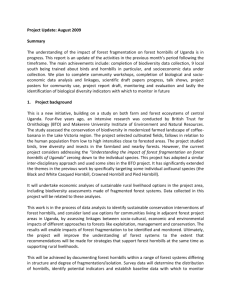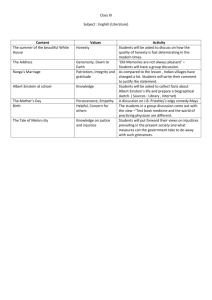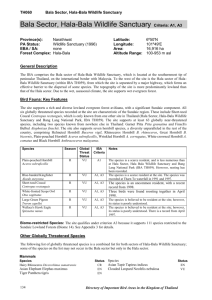STATUS SURVEY OF THE MALABAR PIED HORNBILL IN THE DANDELI... NORTHERN WESTERN GHATS, INDIA THE RAFFLES BULLETIN OF ZOOLOGY 24
advertisement
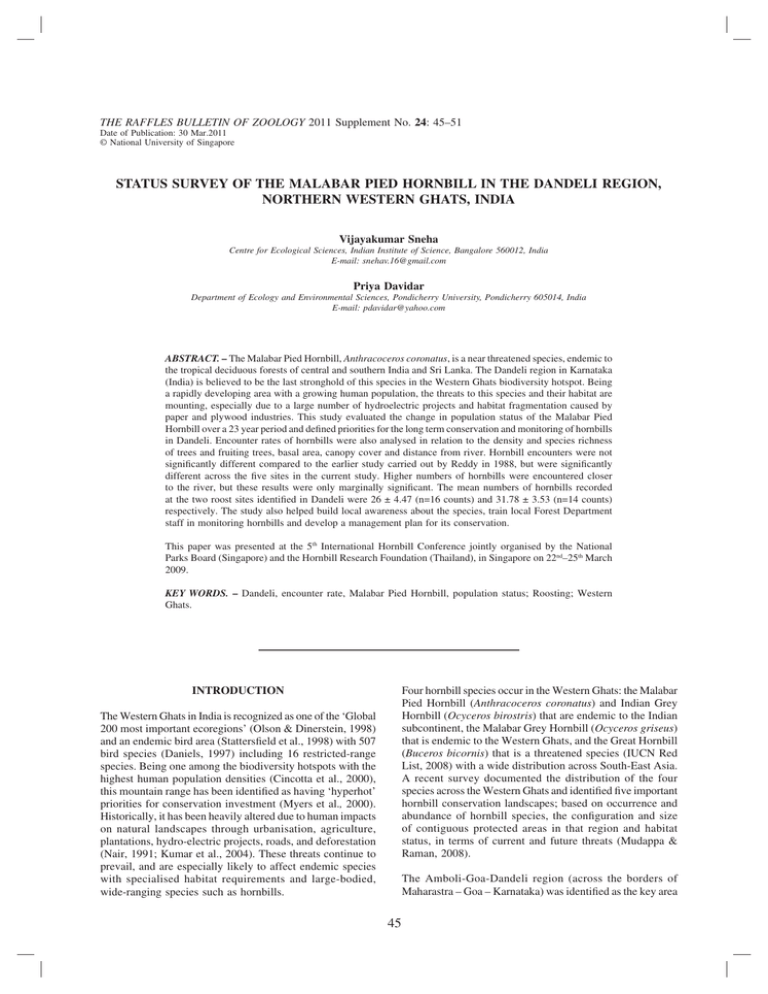
THE RAFFLES BULLETIN OF ZOOLOGY 2011 THE RAFFLES BULLETIN OF ZOOLOGY 2011 Supplement No. 24: 45–51 Date of Publication: 30 Mar.2011 © National University of Singapore STATUS SURVEY OF THE MALABAR PIED HORNBILL IN THE DANDELI REGION, NORTHERN WESTERN GHATS, INDIA Vijayakumar Sneha Centre for Ecological Sciences, Indian Institute of Science, Bangalore 560012, India E-mail: snehav.16@gmail.com Priya Davidar Department of Ecology and Environmental Sciences, Pondicherry University, Pondicherry 605014, India E-mail: pdavidar@yahoo.com ABSTRACT. – The Malabar Pied Hornbill, Anthracoceros coronatus, is a near threatened species, endemic to the tropical deciduous forests of central and southern India and Sri Lanka. The Dandeli region in Karnataka (India) is believed to be the last stronghold of this species in the Western Ghats biodiversity hotspot. Being a rapidly developing area with a growing human population, the threats to this species and their habitat are mounting, especially due to a large number of hydroelectric projects and habitat fragmentation caused by paper and plywood industries. This study evaluated the change in population status of the Malabar Pied Hornbill over a 23 year period and defined priorities for the long term conservation and monitoring of hornbills in Dandeli. Encounter rates of hornbills were also analysed in relation to the density and species richness of trees and fruiting trees, basal area, canopy cover and distance from river. Hornbill encounters were not significantly different compared to the earlier study carried out by Reddy in 1988, but were significantly different across the five sites in the current study. Higher numbers of hornbills were encountered closer to the river, but these results were only marginally significant. The mean numbers of hornbills recorded at the two roost sites identified in Dandeli were 26 ± 4.47 (n=16 counts) and 31.78 ± 3.53 (n=14 counts) respectively. The study also helped build local awareness about the species, train local Forest Department staff in monitoring hornbills and develop a management plan for its conservation. This paper was presented at the 5th International Hornbill Conference jointly organised by the National Parks Board (Singapore) and the Hornbill Research Foundation (Thailand), in Singapore on 22nd–25th March 2009. KEY WORDS. – Dandeli, encounter rate, Malabar Pied Hornbill, population status; Roosting; Western Ghats. INTRODUCTION Four hornbill species occur in the Western Ghats: the Malabar Pied Hornbill (Anthracoceros coronatus) and Indian Grey Hornbill (Ocyceros birostris) that are endemic to the Indian subcontinent, the Malabar Grey Hornbill (Ocyceros griseus) that is endemic to the Western Ghats, and the Great Hornbill (Buceros bicornis) that is a threatened species (IUCN Red List, 2008) with a wide distribution across South-East Asia. A recent survey documented the distribution of the four species across the Western Ghats and identified five important hornbill conservation landscapes; based on occurrence and abundance of hornbill species, the configuration and size of contiguous protected areas in that region and habitat status, in terms of current and future threats (Mudappa & Raman, 2008). The Western Ghats in India is recognized as one of the ‘Global 200 most important ecoregions’ (Olson & Dinerstein, 1998) and an endemic bird area (Stattersfield et al., 1998) with 507 bird species (Daniels, 1997) including 16 restricted-range species. Being one among the biodiversity hotspots with the highest human population densities (Cincotta et al., 2000), this mountain range has been identified as having ‘hyperhot’ priorities for conservation investment (Myers et al., 2000). Historically, it has been heavily altered due to human impacts on natural landscapes through urbanisation, agriculture, plantations, hydro-electric projects, roads, and deforestation (Nair, 1991; Kumar et al., 2004). These threats continue to prevail, and are especially likely to affect endemic species with specialised habitat requirements and large-bodied, wide-ranging species such as hornbills. The Amboli-Goa-Dandeli region (across the borders of Maharastra – Goa – Karnataka) was identified as the key area 45 Sneha & Davidar: Malabar Pied Hornbill status for the conservation of the Malabar Pied Hornbill (Mudappa & Raman, 2008); due to relatively high encounter rates and density of this species. This region is also unique being one of the few which supports all four species of hornbills. Such co-occurrence is possible only in regions with specific patterns of fruit availability, enabling the use of the same forest by both nomadic and territorial species which are divergent in size and dietary specialization (Leighton, 1982). These sites are a part of one of the most forested districts of the Western Ghats biodiversity hotspot, the Uttara Kannada district of Karnataka, with about 75.8% under forest cover (7,807 sq. km). The Dandeli-Anshi Tiger Reserve comprises of two protected areas: Dandeli Wildlife Sanctuary (475.018 sq. km) and Anshi National Park (339.866 sq. km) that are contiguous with each other, forming a single tract of protected area within this district; their vegetation ranging from mixed moist deciduous leading to semi-evergreen and evergreen conditions. The five sites selected are part of reserve forests and do not fall under the protected area network of the Uttara Kannada district. The Malabar Pied Hornbill, Anthracoceros coronatus (Boddaert), is endemic to the tropical deciduous forests of central and southern India and Sri Lanka. According to the IUCN Red List (2008), this species is listed as ‘near threatened’ due to its decreasing population trends. Poaching (Ripley, 1982), habitat fragmentation (Reddy et al., 1990; Zacharias & Gaston, 1999) and deforestation (Tikadar, 1983) are major threats to the species throughout its range. The first detailed study of the species was carried out in the riverine forests of the Uttara Kannada district of Karnataka, in the northern part of the Western Ghats, by Reddy (1988). He monitored the occurrence and seasonal variation in the number of A. coronatus in five selected reserve forests in and around Dandeli. He also carried out detailed observations on foraging and roosting behaviour, recording the specific food plants utilised by the species and their nutritional value. Champion & Seth (1968) classified the Dandeli region (including the five study sites) under Mixed Moist Deciduous forest with tree species like Terminalia paniculata, T. tomentosa, Lagerstroemia lanceolata, Tectona grandis, Salmalia malabaricum, Dalbergia latifolia, Dillenia pentagyna, Grewia tiliaefolia, Adina cordifolia, Emblica officinalis and Xylia xylocarpa. Two species of bamboo, Bambusa arundinacea and Dendrocalamus strictus are also seen in some areas. Due to the construction of dams, rehabilitation programs, exploitation, and human disturbance, Pascal (1988) warned that a change in the floristic composition of these forests was inevitable. Bird surveys. – Line transects were used to sample hornbills in the five selected reserve forest areas. Six lines transects (7.5 km in total) were laid along existing trails in the forest; five of which approximately replicate transects surveyed earlier (Reddy, 1988). The sixth transect was located in the 110-hectare complex of the Timber Depot, which houses the Dandeli Wildlife Division Office and Forest Department Housing Quarters. This transect was used to monitor the activity of hornbills, especially their feeding habits, amidst constant human activity. The Dandeli region, over the last few decades, has been a rapidly developing city with a growing human population. The main industry here, the West Coast Paper Mills Ltd., contributes to extensive habitat fragmentation due to logging. The roost sites of Anthracoceros coronatus located along the River Kali are also under threat. This river supplies water and power, through several dams, to the Paper Mill and the other plywood industries. New hydroelectric projects have also been proposed which will contribute to further habitat loss via drowning of forests. With increasing demands of people, expansion of agricultural activities, mining, and poaching, the threats to this species and their habitat are mounting. Thus, an effective assessment of the population trends and distribution of the Malabar Pied Hornbill in the Dandeli region, the last stronghold of this species, is crucial to aid in its long term conservation. In this study, the current status of the Malabar Pied Hornbill was evaluated in the five selected reserve forests studied earlier by Reddy (1988) and priorities were defined for the long term conservation and monitoring of hornbills in Dandeli. Hornbill abundance was analysed in relation to various habitat parameters, roost sites were identified and roosting behaviour monitored. The study also aimed to build local awareness about the species and train local Forest Department staff in monitoring hornbills. MATERIALS AND METHODS Study area. – Five study sites, namely Dandeli, Haliyal, Kulgi, Ambikanagar and Ganeshgudi, (between 14º 45'N - 15º 25'N and 74º 25'E - 74º 50'E; 300 - 600m a.s.l; Fig. 1) were chosen based on the earlier study (Reddy, 1988). Fig. 1. Map showing the locations of the five study sites (Dandeli, Ambikanagar, Kulgi, Haliyal, and Ganeshgudi) in the Uttara Kannada district (marked in red) of Karnataka, India (Map courtesy – Dr. K. V. Gururaja). 46 THE RAFFLES BULLETIN OF ZOOLOGY 2011 and increased in Ganeshgudi over the years, although the results are not significant (Fig. 2). A single encounter of three birds was observed in Kulgi in January (2007) and there was no record of hornbills in Haliyal during the three month period, as recorded by Reddy (1988) (Fig. 2). Each transect was surveyed nine times in total, across the three-month study period (December 2006 to February 2007; non-breeding season). Transects were surveyed between 07:00 – 09:00 hours at a uniform pace and all visual detections of the study species made within 50m on either side of the transect line were recorded. For each sighting, the following parameters were recorded - number of hornbills, sex (where possible), distance from start of transect, approximate distance from transect line and activity of the hornbill at the time of detection (feeding, calling, flying, preening, perching). In the current study, encounter rates were significantly different across the five sites (Kruskal-Wallis χ2=22.839, df=4, p<0.001) and across the six transects (Kruskal-Wallis χ2=36.734, df=5, p < 0.001; Appendix 1). Habitat characteristics. – Hornbill encounter rate was not significantly related to any of the habitat variables measured (Appendix 1). Only a weak negative correlation was observed between hornbill encounter rate and distance from the river (rs=- 0.771, n=6, p=0.072). Roost sites were identified along the River Kali by observing the direction in which the hornbills flew in the evenings and using information provided by the local people. Roost counts were carried out between 1600 and 1830 hours at these sites across the entire study period. The parameters recorded include number of hornbills, sex (where possible), time of arrival, direction of arrival and activity when sighted (feeding, calling, flying, preening, perching). Roosting behaviour of the hornbills and their movement at the pre-roost gathering site was observed in detail and recorded. Hornbill roost counts. – Three roost sites were identified in the Dandeli region during the study period; two in Dandeli (JLR and IPM) and one in Ganeshgudi. The mean numbers of hornbills recorded at the two roost sites in Dandeli, over the three-month study period, were 26±4.47 (n=16 counts) and 31.78±3.53 (n=14 counts) respectively. The mean number of hornbills recorded in Ganeshgudi, the third roost site, was 30±4 (n=8 counts). Habitat sampling. – A total of 36 belt transects (20m×10m) were used to quantify habitat variables across the five sites. The total density and species richness of trees and fruiting trees, basal area, height of trees and canopy cover were estimated. All trees ≥30 cm gbh were counted and tree density was estimated. Canopy cover was determined by taking 20 present/absent readings of vegetation cover sighted through the cross wires of an ocular tube along the belt transects (James & Shugart, 1970). Additionally, distance of the line transect from the river was also recorded. Roost counts in Dandeli were consistently higher than those recorded during the earlier study (Fig. 3). When roost counts from the two sites in Dandeli (JLR and IPM; approx. 1.5 kms apart) were combined, the increase in numbers of Malabar Pied Hornbills is clearly evident (Fig. 4). Loss of suitable habitat over the years could have lead to the need for two roost sites to help support an increasing hornbill population in Dandeli. Data analysis. – Encounter rates of hornbills in each of the five sites were analysed in comparison to those recorded in the first study carried out in this area (Reddy, 1988), using a Wilcoxon Signed Ranks test. The Kruskal Wallis test was used to compare encounter rates between each of the six transects. Spearman’s correlation coefficients were used to identify the vegetation parameters that correlated significantly with hornbill abundance. The mean number of hornbills at each roost site was determined through roost counts and compared to Reddy (1988). Roosting behaviour. – Flocks of one to six birds were seen arriving at their pre-roost gathering site along the river from different directions. On arrival, they spread out in a linear fashion over 100–200 m on various trees. Between 1600–1715 hours, a number of activities were recorded including loud vocalisation, hopping from one branch to another, feeding on fruit, preening and flying across from one riverbank to the other. Some interesting social displays observed include “play fighting” and “kissing” (as defined in Diamond & Bond, 2003) and a characteristic flight display, hypothesized as a RESULTS Assessing population trends. – Encounter rates of hornbills, across all five sites, did not differ significantly when compared to the earlier study (Reddy, 1988; Wilcoxon Signed Ranks test p=0.173). Taken individually, only Ambikanagar showed a significant increase in encounter rate, compared to the earlier study (Mann Whitney U test p=0.018). It is also important to keep in mind that the data compared here was only across the three month study period (December to February). Although the Malabar Pied Hornbill had not been recorded in Ambikanagar during these months by Reddy (1988), the current study recorded a high encounter rate of 8.5 birds/km (Fig. 2). Hornbill encounter rates have decreased in Dandeli Fig. 2. Encounter rates of Malabar Pied Hornbills (birds per km) in the five selected reserve forests, compared across the three month study period in relation to Reddy (1988). 47 Sneha & Davidar: Malabar Pied Hornbill status form of “play chasing” behaviour (see Sneha & Davidar, 2008 for details and images). After 1800 hours, the hornbills flew back to the roost trees individually or in pairs. They sat motionless on trees and at dusk slowly settled into their roosts, camouflaged against the dense foliage of the roost trees. Occasionally, Malabar Grey Hornbills (Ocyceros griseus) and Indian Grey Hornbills (Ocyceros birostris) were also observed at the roost sites but they did not roost along with the Malabar Pied Hornbills. Egrets (Egretta garzetta) and Night herons (Nycticorax nycticorax) were observed using roost trees neighbouring those used by the hornbills in Dandeli. availability, in the rainforests of the Anamalai hills in the Western Ghats. Malabar Pied Hornbills preferred Ficus and Strychnos fruits in the Uttara Kannada forests as it contains a high percentage of water (Reddy & Basalingappa, 1993). In the Athikadavu valley, also a part of the Western Ghats, various species of figs (Ficus benghalensis, F. drupaceae, F. amplissima) as well as fruits of Strychnos nux-vomica and Putranjiva roxburghii were consumed (Balasubramanian et al., 2004). This preference could also be attributed to higher content of calcium and carbohydrates in these fruits. The fruiting season of these plants is also crucial, for example, in the Dandeli region, Ficus glomerata was observed fruiting throughout the year while fruiting in Strychnos nux-vomica was spread over November to April. This is probably an important factor which helps sustain hornbill populations during the non-breeding season (Reddy et al., 1990). DISCUSSION Hornbills are globally threatened by habitat loss, fragmentation and hunting. Poonswad et al. (1983) warned that the destruction of essential hornbill habitats would eventually result in the extinction of several species. The importance of riverine habitats for the conservation of the Malabar Pied Hornbill has been clearly emphasized over the years (Reddy et al., 1990; Balasubramanian et al., 2004). Mudappa & Raman (2008) recorded the Malabar Pied Hornbill most frequently in lower elevation (<600m) moist deciduous and riverine areas on the Western aspect of the Ghats. Reddy et al. (1990) observed that the distribution and variation in number of Malabar Pied Hornbills (Anthracoceros coronatus) in the Dandeli region was strongly governed by the availability of fruit trees, their fruiting season and availability of suitable roosting habitat. In this study, the hornbills were observed feeding on Styrchnos nux-vomica, Ficus glomerata, F. asperrima, F. mysorensis and Diospyros montana; the main food plants found fruiting between December and March. The availability of fruiting trees did not have a significant effect on the abundance of hornbills; this may be due to small sample size and seasonal variation in fruiting of preferred tree species. However, the presence of a large numbers of hornbills in Ambikanagar could be due to high fruit tree richness in that area. A number of other studies have shown that resource availability strongly influences abundance and distribution of hornbill species. Kinnaird et al. (1996) observed that in a relatively large, contiguous forest, temporal fluctuations in the densities of the Sulawesi Red-knobbed Hornbill (Aceros cassidix) was influenced by the availability of fig fruits, and its spatial distribution was significantly affected by strangler fig density. In North-East India, Great Hornbill (Buceros bicornis) abundance was correlated to large tree density and basal area (Datta, 1998). Kannan & James (1999) identified that Ficus conservation is of paramount importance to the conservation of the Great Hornbill, due to its year-round The relatively open riverine habitats on the banks of the River Kali also provide important roost sites for the Malabar Pied Hornbills. These roosts, consisting mainly of dense patches of bamboo, foliage of Holigarna arnotiana and Terminalia arjuna trees, help sustain large numbers of communally roosting hornbills. They also act as important centers for information exchange between foraging birds and also offer better protection from arboreal and nocturnal predators. Both roosting hornbills and their habitats are highly vulnerable. Reddy et al. (1990) reported poaching of hornbills for meat and medicinal purposes by tribals in Dandeli; over the years, this practice has decreased. No natural predators of the Malabar Pied Hornbill have been observed so far. Thus, the identified roost sites need to be adequately protected and monitored to ensure the continued use of these sites. Fig. 3. Trends in hornbill roost counts (Mean±SE) at the roost site in Dandeli (JLR). Number of days of observation (n): Dec to Feb (1984–86) n= 5; Dec (2007) n= 8; Jan (2007) n=6; Feb (2007) n=2. Fig. 4. Trends in hornbill roost counts (Mean±SE) – comparing data from two roost sites in Dandeli (JLR and IPM) with data from JLR (Reddy, 1988). Number of days of observation (n): Dec to Feb (1984–86) n= 5; Dec (2007) n= 5; Jan (2007) n=6; Feb (2007) n= 48 THE RAFFLES BULLETIN OF ZOOLOGY 2011 Reddy (1988) documented communal roosting of the Malabar Pied Hornbill in Dandeli (JLR) between 1984 and 1986. The highest number of individuals he recorded was 44. The current study estimates a maximum of 61.4±7.5 (Mean±SE) hornbills observed roosting in both these sites combined (JLR & IPM). The roost site at Ganeshgudi also supports a stable population of this species. Local inhabitants believe that the roost site at JLR has been used for about 50 years, in spite of increasing anthropogenic activity like vehicular traffic on the bridge across the Kali, religious activities and the presence of local inhabitants using the river for washing clothes and utensils. The second roost site in Old Dandeli (IPM) has been used only for the last two to three years. The need for a second roost, about 1.5 km from JLR, could be due to the decline in vegetation along the bank of the river. These fragments may not have been able to support a steadily increasing population of the Malabar Pied Hornbill. Another important factor is the presence of fruit trees near the roost sites, for example, the presence of a Ficus glomerata tree at the pre-roost gathering site near IPM. Dense clumps of bamboo also seem to provide a suitable site to roost, especially as it is easier to detect movement of predators along their thin, flexible branches. in the Dandeli-Anshi Tiger Reserve. In association with the Centre for Environment Education (CEE), he has introduced a number of nature awareness and education programs, being conducted in schools and villages in and around the reserve. Recently, a Hornbill Trail has been initiated in Dandeli town (near Transect 6) to spread awareness about the four hornbill species seen here. The possibility for the involvement of trained amateurs, volunteers, and Forest Department staff in hornbill monitoring is also being explored. To tie all these efforts together, a detailed management and action plan for monitoring, protection, and conservation of critical hornbill populations has to be developed by a committee consisting of the local Forest Department officers, non-governmental organizations, local people, along with biologists acting as facilitators. ACKNOWLEDGEMENTS This study was supported by the Wildlife Conservation Society - India Small Grants Program. V.S is deeply indebted to Divya Mudappa and Shankar Raman for spurring her interest in this field and for their suggestions and help. Sincere thanks are due to the Karnataka Forest Department for permission, support and assistance. It is inappropriate to generalize trends in the abundance of hornbills in the five selected reserve forests in the Uttara Kannada district in Karnataka from the limited data set in the current study. However, it is clear that there is an overall increase in hornbill abundance, both in terms of encounter rates and roost counts, as compared to Reddy (1988), reiterating the importance of the Dandeli region as the last stronghold of this species. This could be due to the presence of preferred fruit trees, suitable nest and roost sites and absence of hunting pressure. Systematic long term efforts to estimate population densities, and to discover and monitor nests and roost sites are essential. Protection and conservation of areas much larger than the “preferred” habitats occupied by the hornbills has been advocated (Mudappa & Raman, 2008). LITERATURE CITED Balasubramanian, P., R. Saravanan, & B. Maheshwaran, 2004. Fruit preferences of Malabar Pied Hornbill Anthracoceros coronatus in Western Ghats, India. Bird Conservation International, 14: S69–S79. Champion, H. S. & S. K., Seth, 1968. A Revised Survey of the Forest Types of India. Manager of Publication, Government of India, Delhi. 432pp. Cincotta, R. P., J. Wisnewski, & R. Engelman, 2000. Human population in the biodiversity hotspots. Nature, 404: 990– 992. Daniels, R. J. R., 1997. A Field Guide to the Birds of Southwestern India. Oxford University Press, New Delhi. 408pp. It is important to note that the Malabar Pied Hornbill occurs in many sites outside designated protected areas, including habitats prone to a range of threats such as encroachments, agriculture, monoculture timber plantations, hydro-electric and irrigation projects, tourism and urban development. Therefore, an urgent need to promote hornbill conservation, in these regions in particular, is evident. Mudappa & Raman (2008) found that, at a number of locations across the Western Ghats, there was low awareness of hornbill species occurrence or abundance, even among forest staff in protected areas. Datta, A., 1998. Hornbill abundance in unlogged forest, selectively logged forest and a forest plantation in Arunachal Pradesh, India. Oryx, 32: 285–294. Datta, A., 2001. An ecological study of sympatric hornbills and fruiting patterns in a tropical forest in Arunachal Pradesh. PhD dissertation, Saurashtra University, Rajkot. 266 pp. Diamond, J. & A. B. Bond, 2003. A comparative analysis of social play in birds. Behaviour, 140: 1091–1115. IUCN, 2008. 2008 IUCN Red List of Threatened Species. Downloaded from http://www.iucnredlist.org. (Accessed May 2009). During the current study, children at local schools and a group of wildlife photographers were made aware of the importance of hornbills as an indicator of habitat quality and as a key flagship species. Local awareness about the species was also expanded during interactions with children and local people intrigued by the research. The current Deputy Conservator of Forests has been enthusiastically using the Malabar Pied Hornbill along with the Tiger as mascots for conservation James, F.C. & H. H. Jr., Shugart, 1970. A quantitative method of habitat description. Audubon Field Notes, 24: 727–736. Kannan, R. & D. A. James, 1999. Fruiting phenology and the conservation of the Great Pied Hornbill (Buceros bicornis) in the Western Ghats of southern India. Biotropica, 31: 167–177. Kinnaird, M. F., T. G. O’Brien, & S. Suryadi, 1996. Population fluctuation in the Sulawesi Red-knobbed Hornbills: tracking figs in space and time. Auk, 113: 431–440. 49 Sneha & Davidar: Malabar Pied Hornbill status Kumar, A., R. Pethiyagoda, & D. Mudappa, 2004. Western Ghats and Sri Lanka. In: Mittermeier, R. A., P. R. Gil, M. Hoffmann, J. Pilgrim, T. Brooks, C. G. Mittermeier, J. Lamoureux & G. A. B. da Fonseca (eds.), Hotspots Revisited: Earth’s Biologically Richest and Most Endangered Ecoregions. CEMEX. Pp. 152–157. Reddy, M. S., K. S. Muralidhar, M. R. Gandhi, & S. Basalingappa, 1990. Distribution and variation in number of Malabar Pied Hornbills Anthracoceros coronatus (Boddaert) in selected areas of north Kanara forest of Western Ghats in Karnataka, India. The Indian Zoologist, 14: 63–73. Reddy, M. S. & S. Basalingappa, 1993. The food of the Malabar Pied Hornbill. Journal of Ecological Society, 8: 23–28. Mudappa, D. & T. R. S. Raman, 2008. Hornbills and Endemic Birds: A Conservation Status Survey Across the Western Ghats, India. NCF Technical Report No. 17, Nature Conservation Foundation, Mysore. 58 pp. Ripley, S. D., 1982. Synopsis of the Birds of India and Pakistan. Second Edition. Bombay Natural History Society, Bombay. 552 pp. Myers, N., R. A. Mittermeier, C. G. Mittermeier, G. A. B. da Fonseca, & J. Kent, 2000. Biodiversity hotspots for conservation priorities. Nature, 403: 853–858. Sneha, V. & P. Davidar, 2007. Observations on possible social play in the Malabar Pied Hornbill (Anthracoceros coronatus) at Dandeli, northern Karnataka. Indian Birds, 3(6): 228–230. Nair, S. C., 1991. The Western Ghats: A Biodiversity Conservation Plan. INTACH, New Delhi. Stattersfield, A. J., M.J., Crosby, A.J. Long, & D.C., Wege, 1998. Endemic bird areas of the world: priorities for biodiversity conservation. Bird Life conservation series 7, Bird Life International, Cambridge, United Kingdom. 346 pp. Olson, D. M. & E. Dinerstein, 1998. The Global 200: a representation approach to conserving the Earth’s most biologically valuable ecoregions. Conservation Biology, 12: 502–515. Tikadar, B. K., 1983. Threatened Animals of India. Zoological Survey of India, Calcutta. 296 pp. Pascal, J. P., 1988. Wet Evergreen Forests of the Western Ghats of India: Ecology, Structure, Floristic Composition and Succession. Institute Francais de Pondicherry. 267pp. Zacharias, V. J. & A. J., Gaston, 1999. The recent distribution of endemic, disjunct and globally uncommon birds in the forests of Kerala State, South-West India. Bird Conservation International, 9: 191–225. Reddy, M. S., 1988. Some aspects of ecology and behaviour of hornbills, with special reference to Anthracoceros coronatus (Boddaert) from North Kanara district of Western Ghats. Ph.D. dissertation, Karnatak University, Dharwad. 307 pp. 50 THE RAFFLES BULLETIN OF ZOOLOGY 2011 Appendix 1. Hornbill encounter rate and habitat variables measured in six transects. Transect Encounter rate/km Tree sp. density/ha Tree sp. richness/ 0.1 ha Fruit tree sp. density/ha Fruit tree sp. richness/ 0.1 ha Canopy cover (%) Basal Area (m2/ ha) Distance from river (km) Dandeli 0.7 285.7 8.6 42.8 3.6 67.1 57075.2 1.595 Ambikanagar 7.5 550 15 57.1 4.3 67.1 57781.1 1.18 Kulgi 0.3 310 8 0 0 66 34094.1 10.63 Haliyal 0 340 11 30 3 82 48532.03 1.774 Ganeshgudi 1.7 700 12.1 157.1 2.1 62.8 45340.7 0.28 Timber depot 9.5 220 4 10 1 74 52325.2 0.637 51
